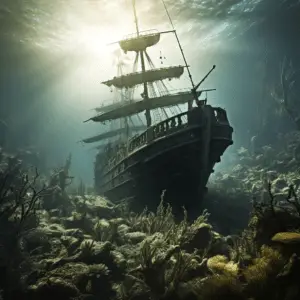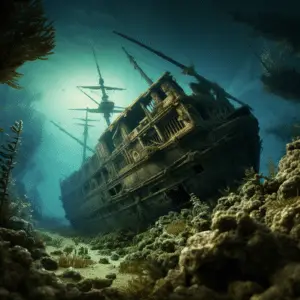Underwater Archaeology, Explorers of the depths have captivated the world with tales of lost civilizations and sunken treasures. Artifacts from the depths offer us a glimpse into our historical tapestry.
Maritime trade routes, naval battles and human adaptation to aquatic environments are all unraveled through underwater archaeology.
Remarkable finds push boundaries of our knowledge. From submerged cities to shipwrecks, each discovery adds to the puzzle of our past.
Accessing and excavating these sites is a challenge. Visibility, currents, and conditions demand specialized skills and equipment.
Yet, when divers uncover centuries-old remains, they get a glimpse into forgotten worlds.
One team of divers discovered an ancient trading vessel off the coast of a remote island. The cargo held clues about ancient trade routes and cultural interactions.
It reminds us of the mysteries still waiting to be revealed in the depths below. Through their efforts, underwater archaeologists illuminate a world that was submerged but never forgotten.
Importance of underwater archaeology

Uncovering the secrets beneath the water’s surface? That’s the role of underwater archaeology! It helps us investigate ancient civilizations, their artifacts and gain understanding about our past. By uncovering submerged landscapes and saving fragile remains, this field boosts our knowledge of human history.
The importance of underwater archaeology is immense. Researchers have made spectacular finds, which grant us insight into long-gone cultures. From sunken cities to shipwrecks loaded with treasure, these discoveries provide us with a peep into our ancestors’ lives.
When looking into the depths of the sea, underwater archaeologists can spot details that are absent from land-based sites. For instance, submerged sites can deliver perfectly preserved materials like wood and textiles due to the lack of oxygen. This offers us a rare opportunity to study objects that would usually decay over time.
One remarkable case is the Egyptian city of Heracleion, which stayed underwater for over 1,200 years. In 2000, Franck Goddio’s team discovered it. This sunken metropolis presented statues, temples and even an entire palace. All these treasures amazed archaeologists around the world and showed the might and value of underwater exploration.
Ancient shipwrecks and artifacts discovered underwater
Uncovering remarkable shipwrecks from the past has become an ever-fascinating pursuit for human knowledge. Here are some archaeological finds that have captivated us:
- The Antikythera Mechanism, found in Greece in 1902. This ancient analog computer astounded archaeologists with its intricate design and advanced technology, dating back to the second century BC. It is a testament to the scientific prowess of ancient civilizations.
- The Mary Rose, a Tudor warship that sank in 1545 off the coast of England. Its excavation in 1971 revealed a treasure trove of artifacts, providing unprecedented insights into naval warfare during that era.
- The RMS Titanic, an infamous maritime disaster, discovered in the North Atlantic Ocean in 1985. It still captures our collective imagination, serving as a haunting reminder of human fallibility.
- The Uluburun Shipwreck from Turkey, unearthed in 1982. It contained an eclectic assortment of artifacts from various cultures around the Mediterranean. Giving us a fascinating glimpse into ancient trade networks and cultural exchanges.
These underwater archaeology discoveries remind us of our never-ending curiosity for the past and our desire to uncover its secrets.
Exploring lost civilizations underwater
Unearth incredible secrets beneath the waves! Discover ancient tombs, statues, ruins, temples and more with underwater archaeology. Have a look at some of the most noteworthy findings:
- Ancient Egypt in Alexandria – Cleopatra’s palace and Pharos lighthouse.
- Maya Civilization in Yucatan Peninsula – stone temples and sacrificial sites.
- Ancient Greece in Sicily – statues and Roman warships.
- Vikings in Denmark – longships and treasure hoards.
Explore the depths of the sea and uncover the history of past civilizations. This is your chance to touch history and bring to light lost wonders. Don’t miss out on this extraordinary journey!
Technological advancements in underwater archaeology
Remote sensing, such as side-scan sonar and multibeam bathymetry, has been a major breakthrough. These tools let archaeologists generate high-resolution pictures of the ocean floor. This allows them to spot secret structures and items that were hidden from sight. By swiftly mapping large regions, researchers can quickly locate potential sites for further exploration.
Remotely operated vehicles (ROVs) have been critical too, in underwater archaeology. They have cameras and arms to explore dangerous underwater regions and collect data without putting human divers in danger. ROVs have been crucial in uncovering well-preserved shipwrecks and retrieving artifacts from great depths.
3D modeling technology has also provided more accuracy and realism to underwater archaeological finds. Researchers combine data from photogrammetry, laser scanning, and underwater photography to make detailed virtual replicas of submerged sites. These reconstructions not only provide visuals, but also help with preservation and teaching.
Challenges faced by underwater archaeologists

Underwater archaeologists face many struggles. One of these is navigating the vast and dangerous underwater terrain. This terrain is often hard to see and has strong currents. It makes it tough to find and access sites.
Plus, excavating underwater brings its own issues. Artifacts are delicate and need special equipment to retrieve and protect them. And the water causes them to deteriorate, so they must be documented and analyzed before being taken out of the water.
Moreover, working with local communities and governments is important for successful expeditions. Developing relationships helps researchers get into restricted areas, get permits, and get funding. Plus, it spreads the message about the cultural heritage beneath the waves.
To fight these difficulties, underwater archaeologists use strategies. Advanced tech like remote sensing and unmanned underwater vehicles help survey large sites quickly. It also gives data for site identification and characterization.
Interdisciplinary cooperation is another key strategy. Working with marine biologists, oceanographers, and engineers helps archaeologists understand marine ecosystems, study sedimentation patterns, and come up with ways to protect and restore underwater cultural heritage.
Conclusion
Diving into the depths of the ocean, underwater archaeology has revealed invaluable insights into our past. Shipwrecks and entire lost cities have been found, giving us a glimpse into events, trade routes, and the lives of long-gone civilizations.
The underwater realm holds a wealth of archaeological wonders. From ancient rivers to the sea, artifacts tell tales from centuries ago. Special techniques preserve delicate remains that would otherwise be lost.
Underwater archaeology also allows us to access sites that were once above water, but have since been submerged. One example is the city of Dwarka, off the coast of India. Here, researchers uncovered pottery and structures dating back thousands of years – a legendary city mentioned in Hindu mythology.
With modern technology, interest in underwater archaeology is growing. For instance, the wreck of HMS Erebus was discovered in Canada’s Arctic waters. This was part of Sir John Franklin’s expedition to find the Northwest Passage in 1845. Archaeologists documented the site, helping to solve one of history’s great mysteries.
Frequently Asked Questions
1. What is underwater archaeology?
Underwater archaeology is the study and exploration of submerged cultural and historical sites, such as shipwrecks, sunken cities, and ancient ports. It involves using specialized diving equipment and techniques to recover artifacts, document findings, and protect underwater cultural heritage.
2. What are some famous underwater archaeology discoveries?
Some famous underwater archaeology discoveries include the Titanic wreck, the ancient city of Alexandria in Egypt, and the Antikythera shipwreck. These discoveries have provided valuable insights into maritime history, ancient civilizations, and technology of the past.
3. How are underwater archaeology discoveries made?
Underwater archaeology discoveries are made through a combination of research, exploration, and fieldwork. Archaeologists use remote sensing techniques, such as sonar and magnetometers, to locate potential sites. They then conduct underwater excavations, using tools like suction dredges and remotely operated vehicles, to uncover and retrieve artifacts.
4. What challenges do underwater archaeologists face?
Underwater archaeologists face numerous challenges, including limited visibility, strong currents, unpredictable weather conditions, and the fragile nature of underwater artifacts. They must also adhere to strict ethical guidelines to ensure the preservation and protection of underwater cultural heritage.
5. Can anyone participate in underwater archaeology expeditions?
Participating in underwater archaeology expeditions usually requires specialized training and qualifications. Diving certifications, knowledge of archaeological principles, and experience in underwater environments are typically necessary. However, there are public programs and opportunities for non-professionals to contribute to underwater archaeological projects under the guidance of experts.
6. How is underwater cultural heritage preserved?
Preserving underwater cultural heritage involves a combination of in situ conservation (protecting sites in their original underwater location), proper artifact documentation and storage, and public education. Legislation and international agreements also play a crucial role in promoting the preservation and responsible management of underwater archaeological sites.
